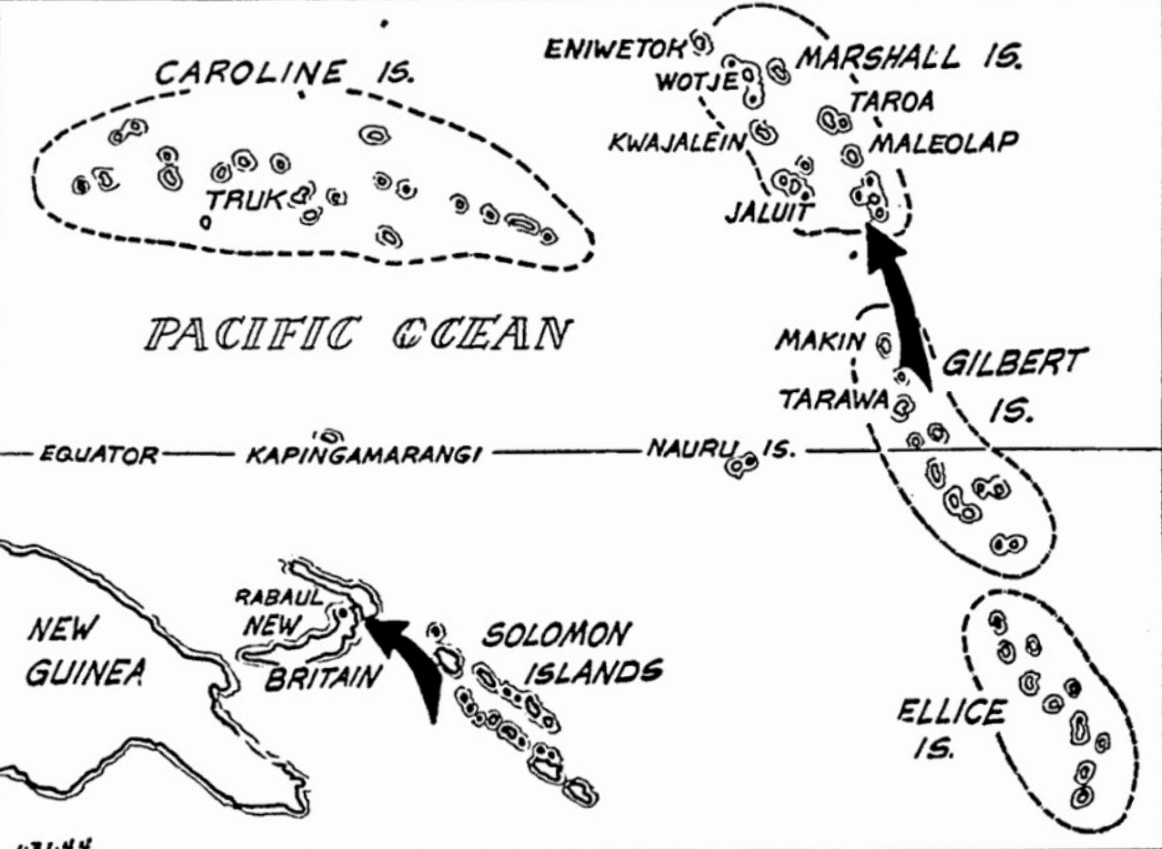The Pittsburgh Press (January 31, 1944)
MARSHALLS INVADED, JAPS SAY
Fleet strikes chain of isles in mid-Pacific
Initial success in new U.S. landing indicated by Tokyo radio
By the United Press
Marshalls invasion is indicated by Tokyo reports of heavy fighting in the mid-Pacific islands. The enemy broadcasts followed U.S. air and naval bombardments of key islands in the archipelago. In the Southwest Pacific, another U.S. raid on the Jap stronghold of Rabaul resulted in the destruction and probable destruction of 62 more Jap planes.
Japanese Imperial Headquarters reported today that powerful U.S. forces are attacking the Marshall Islands athwart the eastern invasion route to Japan and said “furious fighting is now in progress” between Jap garrisons and “enemy troops.”
The implication was plain that U.S. invasion forces had gone ashore in the Marshalls and had met with at least some initial success in establishing footholds.
Even before the Tokyo radio broadcast a communiqué reporting that “powerful enemy troops since Sunday morning have raided the Marshall Islands.” U.S. Fleet headquarters in the Pacific revealed that the air-sea assault on the islands had mounted to a pitch of intensity regarded as a possible forerunner to invasion.
Report heavy fighting
Soon after U.S. Pacific Fleet headquarters in Pearl Harbor announced that a big task force including aircraft carriers and possibly battleships shelled and bombed the Marshalls Saturday and Sunday, Radio Tokyo began a series of broadcasts reporting “fierce” and “heavy” fighting in the area.
Speculation that U.S. invasion troops may have landed on one or more of the atolls was touched off by Tokyo’s varied references to Jap Army units or army troops joining naval forces in engaging the enemy.
Fish for information
It was possible, however, that the Japs were fishing for information as to the task force’s ultimate objective. The Pearl Harbor announcement told only of shelling and bombing attacks on Kwajalein, Maloelap and Wotje Atolls over the weekend and did not disclose whether the naval armada was still in the Marshalls waters.
A London broadcast said that U.S. warships were pumping thousands of shells into Jap installations in the Marshalls from less than 10 miles offshore.
Communiqué broadcast
The first Tokyo broadcast referring to the fighting was a communiqué from Imperial Headquarters transmitted in English by Dōmei and reporting that:
Japanese Army and Navy units have intercepted powerful enemy units which have been attacking the Marshall group since Jan. 30 and fierce fighting is now going on.
Several hours later, a Tokyo broadcast in Italian to Italy said U.S. forces has begun an “offensive” against the Marshalls at dawn Sunday.
Both broadcasts were transcribed by U.S. government monitors.
Naval battle possible
It was regarded as possible that the U.S. fleet had finally succeeded in luring the Jap fleet out for battle.
A Tokyo broadcast in German quoted the communiqué as saying that “troops of the Japanese Army and Navy” stationed in the Marshalls had “engaged enemy forces in fighting.” This version was recorded by the United Press in London.
Includes carriers
Pearl Harbor dispatches indicated the size of the U.S. task force was apparently of invasion dimensions. It included aircraft carriers, cruisers, destroyers and possibly battleships.
The Pearl Harbor communiqué said the task force shelled and bombed the Kwajalein, Maloelap and Wotje Atolls heavily. The force swept into the islands Saturday and naval planes delivered a heavy attack on Taroa Island in the Maloelap Atoll and on Wotje and Kwajalein that day, but no surface attack was mentioned.
Then, instead of retiring, the fleet maneuvered into position for yesterday’s attacks.
Mandated to Japan
If an invasion force was landed, the United States was bidding for the first time for territory which was controlled by Japan before Pearl Harbor. The Marshalls were mandated to Japan by the League of Nations,
The Marshalls are about 600 miles northwest of the nearest U.S. positions at Makin in the Gilberts and less than 750 miles south of Jap-held Wake Island. The group is about 1,200 miles east of Truk, the enemy’s most powerful naval base outside his home waters, and 2,700 miles southeast of Tokyo.
The invasion of the Marshalls group would be the Allies’ second major thrust into the Japs’ Central Pacific island possessions. The first came last November when U.S. Marines successfully invaded the Gilberts.
